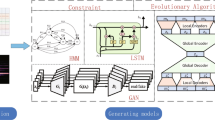Abstract
Automatic music composition and sound synthesis is a field of study that gains continuously increasing attention. The introduction of evolutionary computation has further boosted the research towards exploring ways to incorporate human supervision and guidance in the automatic evolution of melodies and sounds. This kind of human–machine interaction belongs to a larger methodological context called interactive evolution (IE). For the automatic creation of art and especially for music synthesis, user fatigue requires that the evolutionary process produces interesting content that evolves fast. This paper addresses this issue by presenting an IE system that evolves melodies using genetic programming (GP). A modification of the GP operators is proposed that allows the user to have control on the randomness of the evolutionary process. The results obtained by subjective tests indicate that the utilization of the proposed genetic operators drives the evolution to more user-preferable sounds.








Similar content being viewed by others
Notes
The vector of relative differences, \({\bf{r}}\) between two vectors, \({\bf{x_1}}\) and \({\bf{x_2}}\) is computed as \({\bf{r}}=({\bf{x_2}}-{\bf{x_1}})./{\bf{x_1}}, \) were . / is the Hadamard or componentwise division. Every dimension of r describes the relative difference between the components of each dimension of \({\bf{x_1}}\) and \({\bf{x_2}}. \) In the examined case the use of relative differences demises scaling issues that emerge by the inhomogeneous vector of features. For example, for the examined individuals the fractal dimension is between 1.1 and 1.9, while the spectral centroid is between 800 and 1,200.
The participants that used the random depth variation were initially 3, but the results obtained by one of them were discarded because he quit the program after the first generation.
References
Angeline PJ (1997) Subtree crossover: building block engine or macromutation? In: Genetic programming 1997 proceedings of the second annual conference, Morgan Kaufmann, San Francisco, pp 9–17
Burton AR, Vladimirova T (1999) Generation of musical sequences with genetic techniques. Comput Music J 23(4):59–73
Davis S, Mermelstein P (1980) Comparison of parametric representations for monosyllabic word recognition in continuously spoken sentences. IEEE Trans Acoust Speech Signal Process 28(4):357–366
Garcia RA (2000) Towards the automatic generation of sound synthesis techniques: preparatory steps. In: Audio engineering society convention 109
Garcia RA (2001) Growing sound synthesizers using evolutionary methods. Synthesis M(Garcia 2000):99–107
Heikkilä V (2011) countercomplex-bitwise creations in a pre-apocalyptic world. http://countercomplex.blogspot.com/
Heikkilä V (2011) Discovering novel computer music techniques by exploring the space of short computer programs. CoRR abs/1112.1368
Higuchi T (1988) Approach to an irregular time series on the basis of the fractal theory. Phys D 31:277–283
Kaliakatsos-Papakostas MA, Epitropakis MG, Floros A, Vrahatis MN (2012) Interactive evolution of 8-bit melodies with genetic programming towards finding aesthetic measures for sound. In: Proceedings of the 1st international conference on evolutionary and biologically inspired music, sound, art and design, EvoMUSART 2012, Malaga, Spain, LNCS, vol 7247, pp 140–151. Springer
Koza JR (1992) Genetic programming: on the programming of computers by means of natural selection, 1 edn. MIT Press, Cambridge, MA
Lewis M (2008) Evolutionary visual art and design. In: Romero J, Machado P (eds) The art of artificial evolution, natural computing series, Springer, Berlin, pp 3–37
Manaris B, Roos P, Machado P, Krehbiel D, Pellicoro L, Romero J (2007) A corpus-based hybrid approach to music analysis and composition. In: Proceedings of the 22nd national conference on artificial intelligence. AAAI Press, vol 1, pp 839–845
Phon-Amnuaisuk S, Law E, Kuan H (2007) Evolving music generation with SOM-fitness genetic programming. In: Giacobini M (ed) Applications of evolutionary computing. Lecture Notes in Computer Science. Springer, Berlin, vol 4448, pp 557–566
Poli R, Langdon WB, McPhee NF (2008) A field guide to genetic programming. Lulu Enterprises, UK
Putnam JB (1994) Genetic programming of music
Sample of melodies—individuals created during a trial by a participant. http://sites.google.com/site/maximoskp/SampleMelodies.zip (2012)
Shannon CE (2001) A mathematical theory of communication. ACM SIGMOBILE Mobile Comput Commun Rev 5:3–55
Silva S, Almeida J (2003) Gplab—a genetic programming toolbox for matlab. In: Proceedings of the Nordic MATLAB conference, pp 273–278
Spector L, Alpern A (1994) Criticism, culture, and the automatic generation of artworks. In: Proceedings of the twelfth national conference on artificial intelligence, vol. 1. AAAI ’94, American Association for Artificial Intelligence, Menlo Park, CA, USA, pp 3–8
Spector L, Alpern A (1995) Induction and recapitulation of deep musical structure. In: Proceedings of the IFCAI-95 workshop on artificial intelligence and music, pp 41–48
Terasawa H, Slaney M, Berger J (2005) Perceptual distance in timbre space. In: Proceedings of the 11th international conference on auditory display (ICAD2005), Department of Computer Science and Information Systems, University of Limerick, Limerick, Ireland, pp. 61–68
Tokui N (2000) Music composition with interactive evolutionary computation. Communication 17(2):215–226
Tzanetakis G, Cook P (2002) Musical genre classification of audio signals. IEEE Trans Speech Audio Process 10(5):293–302
Wilcoxon F (1945) Individual comparisons by ranking methods. Biom Bull 1(6):80–83
Yan JR, Min Y (2011) User fatigue in interactive evolutionary computation. Appl Mech Mater 48–49:1333–1336
Ziv J, Lempel A (1977) A universal algorithm for sequential data compression. IEEE Trans Inf Theory 23(3):337–343
Acknowledgments
The authors would like to thank the anonymous reviewers for their valuable comments and ideas that helped to improve and extend the content as well as the clarity of this paper. We would also like to thank the participants who voluntarily participated in this research.
Author information
Authors and Affiliations
Corresponding author
Rights and permissions
About this article
Cite this article
Kaliakatsos-Papakostas, M.A., Epitropakis, M.G., Floros, A. et al. Controlling interactive evolution of 8-bit melodies with genetic programming. Soft Comput 16, 1997–2008 (2012). https://doi.org/10.1007/s00500-012-0872-y
Published:
Issue Date:
DOI: https://doi.org/10.1007/s00500-012-0872-y




